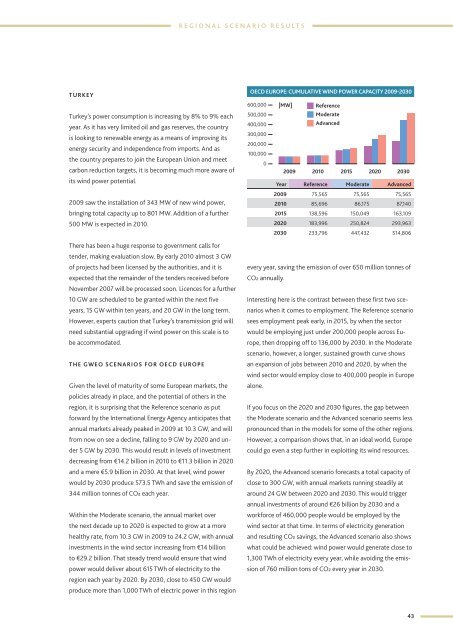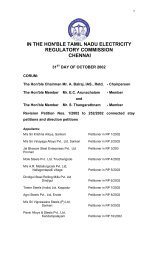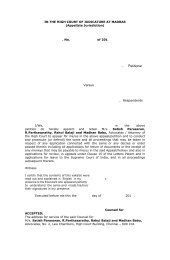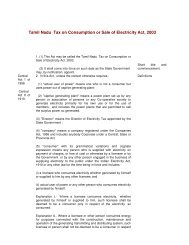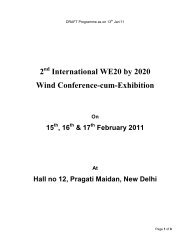glOBal Wind energy OuTlOOk 2010 - Global Wind Energy Council
glOBal Wind energy OuTlOOk 2010 - Global Wind Energy Council
glOBal Wind energy OuTlOOk 2010 - Global Wind Energy Council
You also want an ePaper? Increase the reach of your titles
YUMPU automatically turns print PDFs into web optimized ePapers that Google loves.
R e g i o n a l s c e n a r i o r e s u l T S<br />
Turkey<br />
Turkey’s power consumption is increasing by 8% to 9% each<br />
year. As it has very limited oil and gas reserves, the country<br />
is looking to renewable <strong>energy</strong> as a means of improving its<br />
<strong>energy</strong> security and independence from imports. And as<br />
the country prepares to join the European Union and meet<br />
carbon reduction targets, it is becoming much more aware of<br />
its wind power potential.<br />
2009 saw the installation of 343 MW of new wind power,<br />
bringing total capacity up to 801 MW. Addition of a further<br />
500 MW is expected in <strong>2010</strong>.<br />
There has been a huge response to government calls for<br />
tender, making evaluation slow. By early <strong>2010</strong> almost 3 GW<br />
of projects had been licensed by the authorities, and it is<br />
expected that the remainder of the tenders received before<br />
November 2007 will be processed soon. Licences for a further<br />
10 GW are scheduled to be granted within the next five<br />
years, 15 GW within ten years, and 20 GW in the long term.<br />
However, experts caution that Turkey’s transmission grid will<br />
need substantial upgrading if wind power on this scale is to<br />
be accommodated.<br />
The GWEO scenariOS For Oecd Europe<br />
Given the level of maturity of some European markets, the<br />
policies already in place, and the potential of others in the<br />
region, it is surprising that the Reference scenario as put<br />
forward by the International <strong>Energy</strong> Agency anticipates that<br />
annual markets already peaked in 2009 at 10.3 GW, and will<br />
from now on see a decline, falling to 9 GW by 2020 and under<br />
5 GW by 2030. This would result in levels of investment<br />
decreasing from €14.2 billion in <strong>2010</strong> to €11.3 billion in 2020<br />
and a mere €5.9 billion in 2030. At that level, wind power<br />
would by 2030 produce 573.5 TWh and save the emission of<br />
344 million tonnes of CO2 each year.<br />
Within the Moderate scenario, the annual market over<br />
the next decade up to 2020 is expected to grow at a more<br />
healthy rate, from 10.3 GW in 2009 to 24.2 GW, with annual<br />
investments in the wind sector increasing from €14 billion<br />
to €29.2 billion. That steady trend would ensure that wind<br />
power would deliver about 615 TWh of electricity to the<br />
region each year by 2020. By 2030, close to 450 GW would<br />
produce more than 1,000 TWh of electric power in this region<br />
Oecd Europe: cuMulaTive <strong>Wind</strong> POWer capaciTY 2009-2030<br />
600,000<br />
500,000<br />
400,000<br />
[MW] Reference<br />
Moderate<br />
Advanced<br />
300,000<br />
200,000<br />
100,000<br />
0<br />
2009 <strong>2010</strong> 2015 2020 2030<br />
Year Reference Moderate Advanced<br />
2009 75,565 75,565 75,565<br />
<strong>2010</strong> 85,696 86,175 87,140<br />
2015 138,596 150,049 163,109<br />
2020 183,996 250,824 293,963<br />
2030 233,796 447,432 514,806<br />
every year, saving the emission of over 650 million tonnes of<br />
CO2 annually.<br />
Interesting here is the contrast between these first two scenarios<br />
when it comes to employment. The Reference scenario<br />
sees employment peak early, in 2015, by when the sector<br />
would be employing just under 200,000 people across Europe,<br />
then dropping off to 136,000 by 2030. In the Moderate<br />
scenario, however, a longer, sustained growth curve shows<br />
an expansion of jobs between <strong>2010</strong> and 2020, by when the<br />
wind sector would employ close to 400,000 people in Europe<br />
alone.<br />
If you focus on the 2020 and 2030 figures, the gap between<br />
the Moderate scenario and the Advanced scenario seems less<br />
pronounced than in the models for some of the other regions.<br />
However, a comparison shows that, in an ideal world, Europe<br />
could go even a step further in exploiting its wind resources.<br />
By 2020, the Advanced scenario forecasts a total capacity of<br />
close to 300 GW, with annual markets running steadily at<br />
around 24 GW between 2020 and 2030. This would trigger<br />
annual investments of around €26 billion by 2030 and a<br />
workforce of 460,000 people would be employed by the<br />
wind sector at that time. In terms of electricity generation<br />
and resulting CO2 savings, the Advanced scenario also shows<br />
what could be achieved: wind power would generate close to<br />
1,300 TWh of electricity every year, while avoiding the emission<br />
of 760 million tons of CO2 every year in 2030.<br />
43


